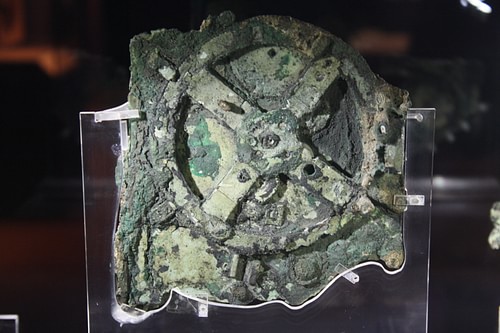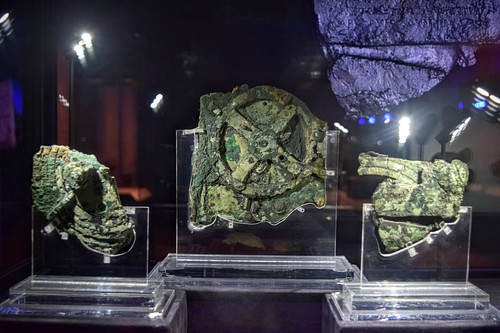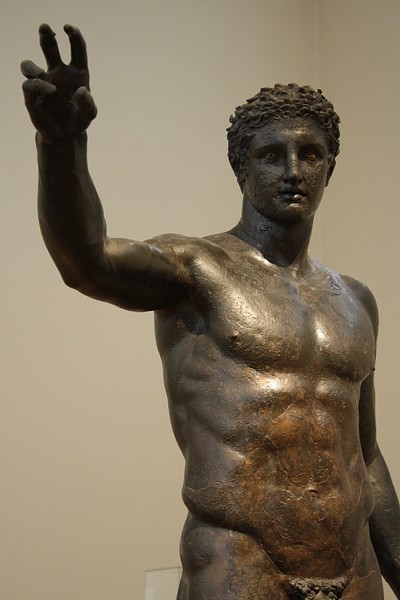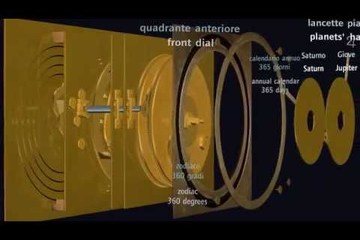
The Antikythera Mechanism (also known as the Antikythera Device), dated to the late 2nd century/early 1st century BCE (roughly 205-60 BCE) is understood as the world's first analog computer, created to accurately calculate the position of the sun, moon, and planets. It was found in 1901 off the Greek island of Antikythera, giving it its name.
The mechanism, thought to have originally been over a foot tall and housed in a wooden box, was discovered as a corroded lump of metal amidst the wreckage of an ancient merchant vessel that also carried statuary, amphorae, and other goods. There were so many artifacts retrieved from the wreckage that the oddly formed and unidentified lump went unnoticed until 1902 when it was seen by the Greek archaeologist Valerios Stais in a workroom at the National Archaeological Museum in Athens. Work on deciphering the meaning and purpose of the device began soon after and continues to the present day.
Mathematician and filmmaker Tony Freeth, part of the University College London Antikythera Research Team that recently solved the mystery of the mechanism, describes the function of the device:
It seems that the device could be used to predict the positions of the sun, moon, and planets on any specific day in the past or future. The maker of the machine would have had to calibrate it with the known positions of these bodies. A user could then simply turn a crank to the desired time frame to see astronomical predictions. The mechanism displayed positions, for instance, on a "zodiac dial" on the front of the mechanism, where the ecliptic was divided into a dozen 30-degree sections representing the constellations of the zodiac. (4)
The device was recognized as some sort of calculator as early as 1905, perhaps a different sort of astrolabe, but significant progress in understanding its purpose only began in the late 20th century. The machine first broke into three pieces after its removal from the sea and then steadily fragmented into 82 smaller parts over the years as it was handled by different researchers, making the puzzle harder to solve. Freeth and his team built a reconstruction of the device in 2021, and today, after over 2000 years, the first analog computer in the world is again functional.
Foundations of Greek Astronomy
The principles of ancient Greek astronomy were derived from the earlier systems of the Babylonians and Egyptians, as noted by scholar Thomas L. Heath:
As early as the second millennium BC, the Babylonians recognized the zodiac as the circle in which the planets move. They divided it into signs of 30 degrees each and, when we are told by Pliny that Cleostratus of Tenedos, who belongs probably to the second half of the sixth century BC, "recognized the signs in it", it is a fair inference that Cleostratus imported from Babylon into Greece the knowledge of the zodiac and the constellations in it, and perhaps of some other constellations. (xvi)
Cleostratus (l. c. 520 to c. 432 BCE) may have introduced the zodiac to Greece, but Greek astronomy was first developed by Thales of Miletus (l. c. 585 BCE) who had studied at Babylon and possibly traveled in Egypt. Thales, among his other accomplishments, is considered the first astronomer of ancient Greece for accurately predicting the solar eclipse of 28 May 585 BCE. It has also been suggested that the innovations attributed to Cleostratus of Tenedos may have been wrongly credited to him by Pliny the Elder, and actually belong to Thales.
Thales' successors in the Ionian school of Greek philosophy (so called because of its origin in Ionia), Anaximander (l. c. 610 to c. 546 BCE) and Anaximenes (l.c. 546 BCE) rejected his claim that water was the First Cause of observable phenomena but seem to have built upon his astronomical work. Whether this is so, or what innovations they introduced, is unclear as none of Thales' works have survived and he is only known through references by later writers.

It is understood, however, that these thinkers established the foundation for what would later be recognized as Greek science by rejecting supernatural explanations for causality and claiming that the universe was rational and knowable. Prior to the Ionians' observations, the traditional understanding of the world, as created and maintained by the gods, was accepted as answering any question on where the world came from and how it functioned. The Ionians, and the Pre-Socratic philosophers who came after them, challenged this view. Scholar Thomas R. Martin comments:
The Ionian thinkers insisted that the workings of the universe could be explained because the phenomena of nature were neither random nor arbitrary. The universe, the totality of things, they named cosmos because this word meant an orderly arrangement that is beautiful (hence our word "cosmetic"). The order characteristic of the cosmos, perceived as lovely because it was ordered, encompassed not only the motions of the heavenly bodies but also everything else: the weather, the growth of plants and animals, human health, and psychology, and so on. Since the universe was ordered, it was intelligible; since it was intelligible, explanations of events could be discovered by thought and research. The thinkers who conceived this view believed it necessary to give reasons for their conclusions and to persuade others by arguments based on evidence. They believed, in other words, in logic (a word derived from the Greek term logos, meaning, among other things, a reasoned explanation). This way of thought based on reason represented a crucial first step toward science and philosophy as these disciplines endure today. The rule-based view of the causes of events and physical phenomena developed by these thinkers contrasted sharply with the traditional mythological view of causation. (91)
The Ionians never denied the existence of the gods; they only challenged how those gods had been depicted by Homer and Hesiod (both of the 8th century BCE) as, essentially, immortal humans with superpowers who, like all humans, were prone to irrational outbursts and emotional responses to which observable phenomena – like the changing of the seasons – were attributed. To the Ionians, there was a much simpler explanation for why things happened as they did, and this was that the universe operated on a set of established laws that could be understood.
Pythagoras & Astronomy
Pythagoras (l. c. 571 to c. 497 BCE) is also considered the first Greek astronomer as he developed a mathematical system that explained planetary movement. Like Thales, none of the works of Pythagoras (if he wrote any) have survived but, based on fragments cited by later writers, he claimed that the First Cause of the universe was Number and that an understanding of mathematical principles was key to understanding how the universe worked. Scholar Thomas Cahill explains:
Pythagoras found deep meaning in numbers. He is credited with discovering that the chief musical intervals produced on the vibrating strings of a lyre can be expressed as ratios: an octave as 2:1, a fifth as 3:2, a fourth as 4:3. Though these relationships still form the basis of Western musicology, Pythagoras went further. Everything, he thought, could be explained by numbers and their relationship to one another. Since the ratios between the basic musical intervals employ only the first four whole numbers, these numbers must be expressive of the deep harmony of the universe, in which the "spheres" or heavenly bodies sing while whirling through space and their music combines in harmonic chords to create the Music of the Spheres, which we are unable to hear only because the sounds are with us from birth and, there being no contrasting silence, we not hear the harmonies. Pythagoras could hear them. (155)
Pythagoras influenced the works of Plato (l. 424/423-348/347 BCE) who then influenced his most famous student Aristotle (l. 384-322 BCE), tutor of Alexander the Great, who brought scholars, also influenced by Aristotle's thought, on his campaign to conquer the Persian Achaemenid Empire, reintroducing the concept that had come from Babylon to Greece to their homeland in a more developed form. Aristotle's views on astronomy, and virtually every other subject, shaped the discussion and development of various disciplines up through the European Middle Ages.

The later astronomers, including Aristarchus of Samos (l. c. 310 to c. 230 BCE), Eratosthenes of Cyrene (l. 276-195 BCE), Archimedes of Syracuse (l. c. 287 to c. 212 BCE), Hipparchus of Nicea (l. c. 190 to c. 120 BCE), and Claudius Ptolemy (l. 100-170 CE) were all, to greater or lesser degrees, influenced by Aristotelian thought, which was informed, in part, by Pythagorean Greek mathematics, which also allowed the famous mathematician Euclid (l. c. 300 BCE) to develop his systems.
The Antikythera Mechanism
These developments enabled the creation of the astrolabe, credited to the astronomer Apollonius of Perga (l. c. 240 to c. 190 BCE) and possibly refined by Hipparchus of Nicea. The astrolabe, a handheld device used to tell time, predict sunrise and sunset, and locate celestial objects, was probably created c. 225 BCE, 20 years earlier than the earliest date given to the Antikythera mechanism. It is possible that the astrolabe, in fact, inspired the later device, though this is speculative.
The most likely inventors of the device are Archimedes of Samos or Hipparchus of Nicea depending on which date one accepts for the Antikythera mechanism. The device is thought to have originally measured 34 centimeters (13 in) tall, regularly described as "about the size of a shoe box", was made of bronze, and consisted of a front and back plate, a central plate as the mounting board for gear trains, a 223-tooth gear at the back, a 127-tooth gear on one side of the central plate, a 38-tooth gear on the other, a 58-tooth gear attached to that, and a total of 69 gears in all, housed in a wooden box with a crank on the side. By setting a date indicator on the front plate and turning this crank, the interlocking gears would engage and provide whatever astronomical information for that date. It is considered the first analog computer in the world because, at the simplest level, it processed continuously varying data.
In 2005, CT scans revealed inscriptions on the back plate which turned out to be a user manual. Scans of the front plate showed it was divided into five sections, each corresponding to the five planets then known – Mercury, Venus, Mars, Saturn, and Jupiter – which inspired Michael Wright, "former curator of mechanical engineering at London's Science Museum" (Freeth, 6) in his work to decipher the purpose of the device in 1990. Wright x-rayed the mechanism and was able to determine how its three fragments originally fit together. Freeth writes:
Wright proposed that an extensive epicyclic system – the two-circles idea the Greeks used to explain the odd reversing motions of the planets – had been mounted on the main drive wheel. Wright even constructed an actual model gearing system in brass to show how it worked. In 2002, he published a groundbreaking planetarium model for the Antikythera mechanism that displayed all five planets known in the ancient world (the discovery of Uranus and Neptune in the 18th and 19th centuries, respectively, required the advent of telescopes). Wright showed that the epicyclic theories could be translated in epicyclic gear trains with pin-and-slot mechanisms to display the planets' variable motions. (8)

The device was used to explain the cycles of the planets, which seemed to sometimes reverse their course, but it could also predict eclipses, star events, chart the phases of the moon, the heliacal rising and setting of certain constellations, the course of seasons and years, and the Olympiad cycle on which the celebration of the Olympic Games was based. The device would have been impossible to create without trigonometry and, if Hipparchus of Nicea is acknowledged as the creator of that system, the mechanism would have to have been created either by him or after his time. It is possible, however, that Hipparchus only developed trigonometry, leaving the possibility open that the device was created earlier, possibly by Archimedes. Whoever created it, the concept required imagination coupled with mechanical, mathematical, and astronomical aptitude of the genius level. Freeth writes:
Any method the Antikythera creators used would have required three criteria: accuracy, factorizability, and economy. The method must be accurate to match the known period relations for Venus and Saturn, and it must be factorizable so the planets could be calculated with gears small enough to fit into the mechanism. To make the system economical, different planets could share gears if their period relations shared prime factors, reducing the number of gears needed. (10)
Once the purpose and technological sophistication of the device was understood, its existence amazed researchers, scholars, and historians who, until that time, held that this level of technology was not developed until the 14th century.
Discovery & Mystery
From the time the device was first recognized as an object of interest, however, it had intrigued the scholarly and scientific community. The ancient shipwreck, dated to c. 70-60 BCE, was discovered at a depth of 45 meters (148 ft) in 1900 off the shores of Antikythera island by Captain Dimitrios Kontos of Symi island and his crew of sponge divers. Kontos contacted the Greek government after one of his divers surfaced with a bronze arm from a statue, and the Hellenic Navy was engaged to help excavate the wreckage.
Initially, the ship was thought to have been carrying spoils looted by the Romans from various Greek cities, but it is now understood to have been a trade vessel carrying cargo from sellers to buyers. Scholar Alexander Jones comments:
We can identify or guess at the places of origin of many of the items on board. There were amphorae of types made in Rhodes and Kos in the Dodecanese, near Ephesus in Asia Minor, and probably also on the Adriatic coast of Italy. The marble of the statues is Parian, so they probably came from a workshop in the Aegean region…the glass is Syro-Palestinian or Egyptian. One of the people on board had his savings in the form of 32 silver coins from Pergamum and Ephesus, and someone was carrying some less valuable coins from Ephesus as well as rather old ones from Katane in Sicily and Cnidos in Asia Minor. The latest of the silver coins were minted between 76 and 67 BC, providing the firmest evidence that the shipwreck occurred after 76 and likely within a span of one or two decades after that year. (2)
Among the many treasures brought up from the wreckage was "a mechanical object composed of wood and metal, about the shape and dimensions of a shoebox" (Jones, 2). According to an early anecdote, possibly apocryphal, the lump of metal was so unimpressive it was almost thrown back into the sea. Instead, it was taken to the National Archaeological Museum in Athens where it was described as "one slab with an inscription, whose letters, however, could not be copied" (Jones, 10). It was placed with other finds from the wreck in a storeroom until 18 May 1902 when it was seen by Valerios Stais, who noticed its interlocking gears and Greek letters through the corrosion. A few days later, the news broke that an 'important discovery' had been made at the Archaeological Museum, but, although the object was certainly now of greater interest than before, no one knew what it was.
Between 1905 and 2021, researchers, scholars, scientists, technicians, and others have worked to discover the purpose and function of the device, but early efforts failed because they lacked the necessary technology. Only with modern equipment could the inner recesses of the device be accessed and understood. Even though Freeth's team seems to have successfully recovered and built a modern version of the mechanism, even he claims that, lacking certain key original parts, their analysis and conclusions may be incomplete.
Conclusion
Even so, the work of the Antikythera Research Team, if it has not completely reconstructed the device, has certainly greatly advanced understanding of its function and purpose. Freeth sums up the importance of the Antikythera mechanism in the closing comments of his fascinating article on the team's efforts, cited in the bibliography below:
The device is unique among discoveries from its time. It single-handedly rewrites our knowledge of the technology of the ancient Greeks. We knew they were highly capable – they built the Parthenon and the Lighthouse of Alexandria even earlier than the Antikythera mechanism. They had plumbing and used steam to operate equipment. But before the discovery of the Antikythera mechanism, ancient Greek gears were thought to be restricted to crude wheels in windmills and water mills…The Antikythera mechanism, with its precision gears bearing teeth about a millimeter long, is completely unlike anything from the ancient world. (12)
Based on the sophistication of the device, it is thought it was the final product of a series of prototypes, now lost, and that it was only one of many such mechanisms produced once the mechanics of constructing it had been mastered. It is possible, then, that there are many other similar devices in other shipwrecks or buried under modern cities awaiting discovery. Even if there are not, the Antikythera mechanism is enough to prove that the ancient Greeks – like all the other civilizations of antiquity – were far more advanced than the modern world often gives them credit for.











![First Philosophers (00) by Waterfield, Robin [Paperback (2009)]](https://m.media-amazon.com/images/I/31xqFV6mK5L._SL160_.jpg)